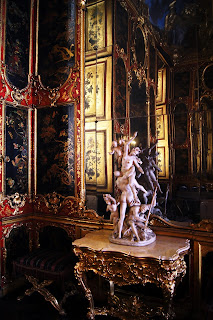
Forgotten ruins like many in Rome, on the route to the first in the history of the baroque building—the church Il Gesu—this beautiful symbol of counterformation and the beginning of absolutism, and the peak of human skills in the field of art—visit not many tourists, but rather those who actually know something more about Rome. And what are the ruins that are not mentioned in guidebooks? A cat shelter. Nowadays, it's an informal shelter for stray cats; every cat that comes here is protected; it must not be harmed; and people from nearby homes bring food to them. As for the southern countries, which, to put it mildly, care less about the fate of others, it is a solution to fight homelessness. But why here? Because it was here that the first Christians really died—not in the Colosseum, which also watched the deaths of many martyrs, but definitely later. Here died also somebody else... Area Sacra dell'Argentina is a remnant of a great complex that included Pompey's theater. The first theatre in the Rome empire. Here should be said who was Pompeius Magnus, the second man in history who obtained the name '' the Great '' in antiquity.
Pompeius Magnus, Cassius, and Julius Caesar, the founders of the first triumvirate, shared the technical reality power of the Roman Empire, which was still a republic at least on the papal level. Julius Caesar even gave his daughter the right to marry Pompey. It was rather a successful marriage, even though her father had his own business. Day by day, Pompeius was more popular in Rome; after all, he conquered the eastern part of Europe, which was much richer than the full forests of France. Caesar couldn't accept that man who was famous for his futility and ambicious for satisfaction, for which he was able to do everything. After eliminating the politic Crassus, it was time for Pompey. Initially, Pompeius must run from Rome. At the beginning of the civil war, he wins at Dyrrachium, but he loses the battle of Farsalos, as a result of which he must take refuge in Egypt. He counts on the support of his young brother Cleopatra VII Philopator (in history, there were seven queens with that name), but the Ptolemy family has other plans. Pompey, after descending ashore, is murdered, and his head is sent to Caesar, who had just arrived in Egypt.
Caesar becomes the most powerful man, but his mania for power, or perhaps more mania for the power of his current partner, who wants to be the ruler of not only Egypt, doesn't meet the acceptance of the senators. At that time, the Senate was sitting in the Pompeii theatre, and in one of the corridors stood his bust. March arrives... Rebuffed, Crassus thought about vengeance for a long time, as did Ceasar, not his legal son Brutus. Caesar, killed by 23 blows with a dagger, falls in front of the bust of Pompey, probably one of the greatest jokes of history.
Today, Area Scara dell Argentina is a ruin, a forgotten ruin of a huge
complex. In the restaurants, not far away, you can try wine in the remains of the theatre's underground. Pompeii theatre was amazing, and we can say that thanks to the murder in that place, the Roman Empire was born with caesars on thrones ( in fact, the Roman rulers were called caesars in honour of the murdered, not emperors). On the small market with vegetables, you can feel today's Italian life, a little visited place ... even for restaurants, climate should be visited more often.
not typical international site, inform about place on international site of city of Rome:
https://www.rome.net/area-sacra









































